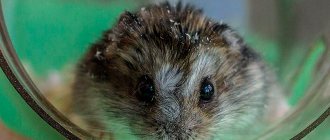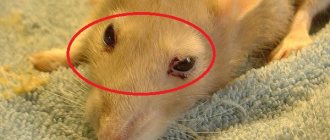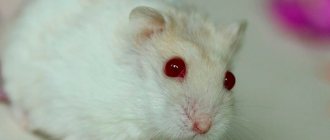Symptoms of the disease
Eye diseases in hamsters can be recognized by the following signs:
- the hamster's eye is very swollen and does not open;
- the eyelid area is always wet and sticks together;
- the hamster's eye waters, a purulent fluid of a grayish or yellowish color is constantly secreted, sometimes with blood;
- a stye or lump may appear;
- inflamed areas become red.
These are clear signs that there is inflammation inside the animal’s small body. This is why a hamster's eyes won't open. A sick pet will behave differently - its activity sharply decreases, it becomes inactive, and sleeps most of the time of the day. During this illness, hamsters may completely refuse to feed and drink.
This may be conjunctivitis, the treatment of which is very complex and lengthy. But often the hamster’s organ of vision turns sour and festers due to other diseases, which are much more difficult to cure. For example, if it’s a cold, the hamster’s eye festers, plus he may sneeze, cough, and wheezing appears in his breathing.
How to deal with this scourge? Our tips and recommendations below will help you with this. But first, we will list the main diseases of the organs of vision in the domestic hamster.
Eye diseases associated with aging changes in the body
Very often, with age, hamsters develop such an unpleasant disease as cataracts. It manifests itself as white spots, clouding of the lens, and blurred vision. The animal gets really stressed because it begins to see poorly. Unfortunately, this disease can rarely be cured; all that remains is to make the animal’s life as easy as possible by following certain tips:
- Do not place the hamster's cage in direct sunlight, this will further irritate the eyes and worsen the situation;
- Don't give your animal a lot of sweets. In return, give a lot of carrots and zucchini.
- Do not place many objects in the cage, because due to poor eyesight the animal may hit them and injure itself.
This is all you can do for your pet to somehow make his life easier.
If it doesn't open
Only the attending physician - a veterinarian - can help establish the correct diagnosis. Therefore, if the hamster’s eyes do not open, you urgently need to take your pet and take it for examination.
If for some reason you are currently unable to visit a veterinarian, you will need to do the following:
- A hamster whose eyes are sour, inflamed and completely closed should be quarantined, that is, separated from his fellow cagemates.
- The animal’s home, as well as all accessories that are in it, must be disinfected (a solution of potassium permanganate or soda solution can be used as an antiseptic).
- At home, you can drip a rodent's eye with special Albucid drops, which are sold in any pharmacy. You need to drip every day so that your hamster's inflamed and swollen eyelids fully open.
But before instilling this medicine, you need to treat the inflamed area with saline solution. Soak a cotton swab in the warm solution and drop it onto the inflamed area. In the absence of saline solution, you can use ordinary boiled water. Its temperature should not be higher than room temperature. With suppuration, bleeding and protrusion of the organs of vision in hamsters, the drug “Tsiprovet” helps very well.
Redness
You can wash your eyes yourself
If a hamster has one eye closed, but has not festered, but only turned red, at first you can help him on your own. At home, you can make a weak saline solution from boiled water and wash the inflamed organ with it several times a day. Salt as an antiseptic eliminates any pathogenic microflora formed on the mucous membrane. You can also use chamomile infusion or black tea brew as an antiseptic. You need to wash your hamster's inflamed organs of vision at least three times a day.
If such preventive treatment is useless and you have not opened your pet's eyes, you need to take your pet and show it to a veterinarian.
Prevention
Knowing that rodents are predisposed to eye infections, you need to take care of prevention:
- once a year examination by a ratologist;
- cleaning the cage and room with the addition of disinfectants once a month;
- creating a healthy diet;
- adding vitamin complexes;
- daily change of water and cleaning of drinkers and feeders.
It is important to limit the animal’s free movement around the house. It is necessary to prohibit children from feeding their pets with prohibited foods. After direct contact with an animal, you should wash your hands with soap. Under such conditions, the owner will be able to ensure the health of the animal for a long time.
Conjunctivitis
This disease affects not only people, but also animals - the hamster is no exception. Moreover, the treatment of such a disease is quite difficult for domestic hamsters. In some cases, if timely measures are not taken, the animal may simply die.
Conjunctivitis is the initial stage of one of the most serious pathologies in an animal. If a hamster's eye festers and does not open, perhaps some kind of infection or virus has settled inside its body. At an advanced stage, conjunctivitis can cause the development of keratitis, and then it is not far from such a pathology as protrusion of the cornea. What to do in such a situation so as not to trigger the disease?
Therefore, if a hamster’s eye is swollen, very swollen, and its owner does not pay attention to his pet, first the rodent may go blind, then die completely.
The same outcome awaits those pet rodent lovers who do not approach the treatment of their animals competently. Remember that any treatment prescribed independently can result in disastrous consequences for your own household.
With a timely response to an animal's illness, you will never have a question about why the hamster's eye popped out or why it was completely closed and festered.
Symptoms of the disease and cause of development
There are several reasons that lead to the development of the disease. Pathogenic microorganisms enter the eyelid or mucous membrane of the eye, for example, from a previously ill animal. The danger is caused by the entrance gates for pathogens that are formed during injuries. Rodents are prone to fights, so eye wounds are considered common.
The development of conjunctivitis after contact with allergens is much less common. An allergic reaction to the irritant will be followed by lacrimation, itching, and then, if no action is taken, the first signs of conjunctivitis will appear.
Symptoms of the disease:
- redness of the skin around the eye and mucous membrane;
- wet groove near the tear duct;
- suppuration, sticking of eyelids;
- itching;
- increase in body temperature.
As for the behavior of the animal, it is either lethargic and sleeps a lot, or, on the contrary, aggressive. Appetite may be completely absent, but sometimes owners note a tendency to overeat.
As soon as such symptoms appear, it is necessary to isolate the individual from the rest, treat the cage, drinking bowls and feeders with disinfectants. If there is a child in the family, you need to limit direct contact. The next step is to take the rodent to the doctor. Self-treatment of conjunctivitis in a hamster is prohibited.
Blepharitis
This disease may be a consequence of advanced conjunctivitis. In this case, the inflamed eyelid sticks together, and the inflammatory process spreads deeper and deeper inside. At an advanced stage, both organs of vision may be closed. This disease is accompanied by redness and swelling of the eyelids.
What to do in this case? This disease can be treated if you consult a veterinarian in time. Often the treatment regimen is identical to the treatment regimen for conjunctivitis. Often, special eye drops are used in the treatment of this disease, for example Tsiprovet or Floxal, as well as additionally tetracycline ointment.
With this disease, the hamster should be put on a diet and the cage should be disinfected.
Hamster's wet tail
“Wet tail” or proliferative ileitis is an infectious disease of hamsters. It is characterized by a severe course, a high degree of contagiousness between rodents and the possibility of death of the animal. The main symptoms are wet fur on the back of the hamster's body around the tail, severe diarrhea with an unpleasant odor, and decreased or absent appetite. If a disease is suspected, it is necessary to immediately isolate the sick hamster from the rest, disinfect the cage, and it is better to get rid of its contents. This disease does not tolerate delaying a visit to the veterinarian for professional assistance. Dehydration is a serious threat to a hamster's life. Prevention of “wet tail” comes down to maintaining hygiene, living conditions and a balanced diet for hamsters.
Diarrhea can be caused not only by the causative agent of proliferative ileitis. Errors in feeding, other infections or the use of antibiotics lead to similar symptoms: bloating, diarrhea, decreased appetite and lethargy. For an accurate diagnosis, it is necessary to examine the hamster at a veterinary clinic.
Bulging eyes
This is more likely not a disease, but a consequence of injury to the eyeball, which has a bad effect on the general condition of the animal. A hamster can damage its eyes both in the fight against other rodents for survival and from dangerous objects contained in the cage - wood chips, sawdust, wire, etc.
As a result of injury, the invading pathogenic bacteria begins to rapidly multiply, penetrating even under the eyeball itself. Such a pet will most likely face surgery to remove the damaged organ. Otherwise, the bacterial infection can develop further, affecting the entire body. Then the rodent can no longer be saved.
Video “Caring for Hamsters”
How to properly care for hamsters so that they never get sick is described in the video below. Video taken from the Rostovlife City Portal channel.
Sorry, there are no surveys available at this time.
Was this article helpful?
Thank you for your opinion!
The article was useful. Please share the information with your friends.
Yes (100.00%)
No
X
Please write what is wrong and leave recommendations on the article
Cancel reply
Rate the benefit of the article: Rate the author ( 5 votes, average: 4.20 out of 5)
Discuss the article:
Belmo
A separate case, although not uncommon, is when a hamster has a white spot on its eye. Veterinarians call this pathology a thorn. The main reason that a hamster's eye turns white is trauma, in some cases cataracts.
It also happens that a hamster has a white spot on his eye that completely covers the entire eye. Homkin's white eyes need to be examined by a veterinarian to determine whether it is an injury or indeed a cataract. But neither one nor the other is an infectious disease, so it cannot be treated with any drops or ointments. Your pet will continue to live, but with the resulting defect.
Tumors and neoplasms
Tumors (malignant, benign), pathological growths on the body, legs. ears is a fairly commonly diagnosed pathology in rodents, which can develop for a variety of reasons. Bumps can appear due to injuries, severe bruises, or falls from a height. To begin treatment, you need to establish a diagnosis, so take your pet to a veterinarian.
For benign and malignant tumors, surgical treatment will be prescribed. If the cancer is localized in a hard-to-reach area (oral cavity), or the tumor has metastasized, veterinarians recommend euthanizing the hamster, since no treatment method will give the desired result.
Well, the most serious category of diseases are tumors and neoplasms, which are very common in hamsters. And, it may not necessarily be cancer, as many rodent owners think, but also the consequence of an unfortunate lump as a result of a bruised limb. But, in order for all your doubts to be dispelled and the rodent to be correctly diagnosed, contact a specialist.
Eye pseudo-diseases
Monitor your hamster's immunity
Often the cause of eye inflammation in a domestic hamster can be another disease. This phenomenon is possible if the rodent’s cheek pouches become inflamed. As a result, the animal's eye hurts, waters, and the lower eyelid swells. After some time, the eye can be observed to stick together and increase in size.
In such a situation, you need to do the following - seek help from a veterinarian. There is such a procedure as cleaning the cheeks. It will not only ease your pet’s suffering, but also relieve such consequences as redness, swelling, inflammation and suppuration of the eyes.
Treatment of diseases
After the examination and identification of the disease, the veterinarian prescribes treatment for his “little patient,” which consists of several stages:
- if a hamster’s eye festers, this is a sign of a bacterial infection that needs to be destroyed;
- saving the eyeball, if possible;
- reduce the risk of further damage to the organ of vision;
- numb the painful area;
- and only at the very end the specialist begins to treat the underlying disease that caused inflammation of the visual organs (glaucoma, dental disease, injury, etc.).
Diet restrictions
Consider one more point: the immunity of a sick rodent, like that of any pet, weakens during illness. Therefore, special attention should be paid to nutrition here. You can feed the animal only approved products. You should also exclude some permitted treats from your diet so as not to aggravate the course of the disease.
Dietary treatment consists of cereals, a small portion of animal protein. The animal's water needs to be changed several times a day.
If within a few days you have not noticed an improvement in the condition of your sick pet, you have no other choice but to take him to the veterinarian.
Oral and dental diseases
Hamsters, like any rodents, grow their incisors throughout their lives, so owners should pay special attention to oral hygiene and the animals' teeth. If the pet does not grind down its teeth, this will lead to injury, damage to the oral mucosa, the development of acute inflammation, the formation of abscesses, and abscesses.
Pathologies and dental diseases in Djungarians and Syrians are manifested by redness of the mucous membranes, hypersalivation, decreased appetite, weight loss, abnormal growth, deformation of the incisors, and inflammation of the cheek pouches.
Inflammation of the cheek pouches is one of the most commonly diagnosed pathologies. It is characterized by inflammation, prolapse (prolapse), and the appearance of pathological formations.
The disease develops due to injury to the oral mucosa. With this pathology, the animals behave restlessly, rubbing their cheeks and muzzle with their paws.
Appetite decreases. Saliva flows from the mouth.
As a rule, the pathological process affects the inner surface of the cheeks.
To relieve inflammation, you need to rinse your pet’s mouth with an antiseptic solution or chamomile decoction. To normalize digestion, give your hamster probiotics and enzymes.
For neoplasms, surgical treatment, restorative, and symptomatic medications are prescribed.
If your hamster has inflamed cheek pouches, treatment should be carried out by a veterinarian. The specialist will carefully turn out the cheeks and clean them of food debris. Inflammation will be relieved by bactericidal drugs, antiseptics, and medications for local and general treatment. After therapy, the hamster must be kept on a fasting diet for 12–14 hours.
Preventive measures
Agree, it is better to prevent any disease in domestic hamsters than to treat it later. And for this you need to create the necessary conditions for your pet. Considering the causes of such diseases, caring owners should:
- Use cage mats specifically designed for hamsters. Such material should not contain piercing or cutting objects, as well as a lot of dust.
- You should not keep a large number of rodents in one cage. They can injure each other, which will result in various diseases, including eye diseases.
- Genetically predisposed individuals must be immediately excluded from the general “herd.” Such hamsters can be a carrier of an infection from birth, transmitted to them from their mother or father.
- During the keeping process, the cage with rodents must be placed in a bright place, but protected from the sun. Direct exposure to sunlight and ultraviolet radiation negatively affects the health of pets.
- Regular examination of animals will help you at an early stage to identify not only carriers of diseases, but also to prevent the development of an already established disease in hamsters.
Medicines for diseases in hamsters
Remember that a number of medications are dangerous for hamsters, and their use can lead to death. Antibiotics dangerous for hamsters include:
- penicillin
- ampicillin
- erythromycin
- gentamicin
- lincomycin
- cephalosporins
Never use an antibiotic without your doctor's advice.
To prevent any disease in hamsters, follow sanitary and hygienic rules, such as regular cleaning and disinfection of the cage, preventing contact with sources of disease, as well as adequate feeding and optimizing the hamster’s living conditions.











